By Anjum Choudhry Nayyar
 It’s long been known that wearing or carrying your baby on your body can be extremely beneficial for both baby and mom. In tribal communities in India, mothers wear their babies to allow them to continue their work on a daily basis. Today moms like wearing their babies for various reasons including juggling traveling with a child, doing chores inside and outside the house and for ease with nursing. But with so many carriers on the market, choosing the right one for your body and lifestyle can be a challenge. We spoke to Sarah Kaplan, mom and owner of Evymama, a Toronto business with two boutiques in the city and Toronto’s largest selection of baby carriers, to give us the inside scoop on what to wear your baby in and how to do it safely.
It’s long been known that wearing or carrying your baby on your body can be extremely beneficial for both baby and mom. In tribal communities in India, mothers wear their babies to allow them to continue their work on a daily basis. Today moms like wearing their babies for various reasons including juggling traveling with a child, doing chores inside and outside the house and for ease with nursing. But with so many carriers on the market, choosing the right one for your body and lifestyle can be a challenge. We spoke to Sarah Kaplan, mom and owner of Evymama, a Toronto business with two boutiques in the city and Toronto’s largest selection of baby carriers, to give us the inside scoop on what to wear your baby in and how to do it safely.
What things should you consider before buying a baby carrier?
You should look at how often you think you’ll be carrying your baby, the age and weight of your baby, your body type, and if you’ve had any injuries to your neck, shoulders, hips, or back.
What carriers are good for those moms who aren’t as active as others?
If you’re going to be mostly at home or in one place and you’re not going to be wearing them that much, then pouch slings are a good choice for their compactness, and simplicity of design. You have to work the baby in, as the pouch is not stretchable; you’ll have to squish the baby into the carrier a little but younger babies don’t mind and actually enjoy the closeness after being in utero.
The ring slings are also nice for their compactness and versatility. You can get the baby in with one hand, which is useful for moms who never have a free hand.
What carriers work best for long-term use?
The non-stretchy, soft structured type of carrier is better for longer-term wear. Men like the ergo carrier as much as moms. It’s a good carrier for sharing.
A stretchy wrap carrier can only really be worn for smaller babies because it starts to sag and droop under the weight of heavier children. It’s not really a safe position for them.
 The Mei Tai is the most versatile option. I can recommend them from birth to a very large child. The Mei Tai works really well, because it wraps really snugly and close to the parent, and the legs of newborns can be tucked-in. The legs of a baby should never be dangling: they should always be a in a seated position and when they’re newborn they should be in a fetal position whether they’re upright or lying down. Babies are prone to hip displacement. When babies are hanging by the crotch the hip is not engaged in the socket and hip dysplasia can occur much more easily.
The Mei Tai is the most versatile option. I can recommend them from birth to a very large child. The Mei Tai works really well, because it wraps really snugly and close to the parent, and the legs of newborns can be tucked-in. The legs of a baby should never be dangling: they should always be a in a seated position and when they’re newborn they should be in a fetal position whether they’re upright or lying down. Babies are prone to hip displacement. When babies are hanging by the crotch the hip is not engaged in the socket and hip dysplasia can occur much more easily.
When can you carry your baby on your back?
At approximately 5 months.
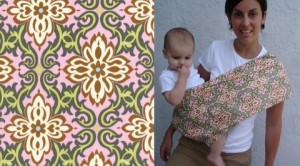 What should you make sure your carrier has for safety?
What should you make sure your carrier has for safety?
1) Check for cracks in buckles
2) Baby should never be “chin to chest,” meaning their chin should not be touching their chest: this position blocks their already narrow, funnel-shaped airway.
3) Backs should be straight; knees above bum
4) Make sure you can see your feet. Move your baby to your back if you can’t so that you don’t trip on things.
Here’s a description of the most popular baby carriers:
Mei Tai is an extremely versatile baby carrier of Chinese origin. It is composed of a rectangular body with four straps. While traditional Mei Tais typically have four narrow straps of equal length, Western versions of this baby carrier usually have shorter straps for the waist and longer, wider, and sometimes padded straps for the shoulders, to allow for more variation in wearing them. Many modern versions of this baby carrier have a headrest or even a sleeping hood to hold up the head of the sleeping child, particularly useful when they are positioned on your back.
What remains of the traditional Mei Tai is their decorative aspect and their enduring practicality. Mothers and fathers alike enjoy wearing this workhorse of a baby carrier. Most are reversible from a decorative side to a plain solid coloured one, allowing for more wearability.
Children can comfortably be worn in a Mei Tai from birth to about 35lbs.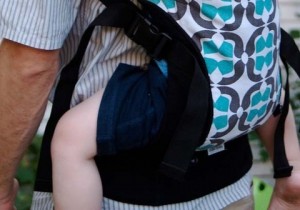
Good soft structured baby carriers are essentially Mei Tais with buckles. It is essential that your baby carrier offers good support for both the wearer and the baby, that the fabric is breathable and natural wherever possible, and most importantly, that the child’s legs do not dangle from it, which strains their leg sockets and compresses their spine. Once your baby is old enough to be held in your arms on the hip, they should be in a seated position (legs astride). Prior to this they may be held in these carriers in the froggy position, legs tucked in, or in various modified cradle holds, in some cases with the aid of an infant insert.
There are both knit (stretchy) and woven wrap carriers. Stretchy wraps are best suited for younger, lighter babies, as they will sag under the weight of an older child.
A wrap can become a blanket on a cold day, a sunshade on a sunny day, a change pad when you forgot yours, a rain cover when it’s wet, and a seatbelt when there’s no highchair. We could go on.
Wraps can be worn on the front, back, or hip, with the baby facing in or out. A wrap will take your baby from birth until they no longer wish to be carried. Children of all ages can nurse easily in a wrap.
Pouches are for the laissez-faire personality. They are simple and elegant, easy to put on and take off, and are available in a wide array of fabrics.
They are not designed for sharing, however. Your pouch must be fitted to you exactly, and certain brands may fit certain people better than others. There is not as much versatility with a pouch as with other baby carriers, but they are certainly lovely and easy to pack in your purse.
Pouches are best for newborns and smaller babies, or for older, heavier children on short trips with them on your hip in the carrier. Small babies can only be held in the cradle position in these carriers, and older children can be held upright.
Ring slings are quite a versatile baby carrier type. They are comprised of a long piece of fabric of varying lengths and widths, with two rings that act as a buckle. It goes on like a sash (think Miss America) and is tightened by pulling on the tail of the sling. Finer adjustments are made by pulling on the rails, or edges. The baby can be held either upright in a froggy position or in a cradle hold at birth, and later on can be held on the hip, the back, and in a variety of ways.
This type of carrier is best for young babies, and for older or heavier children only if you are taking a quick trip and need your hands free for a little while. Once baby is 15 to 20 lbs, many parents find that the weight on one shoulder is too much to bear for any length of time.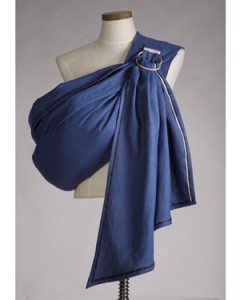
For more information on baby carriers visit: http://evymama.ca/collections/mei-tai-carriers
Sarah Kaplan is the President of Evymama Nursing and Maternity located in Toronto. Sarah is trained and slated to train in Lactation Management with INFACT Canada.


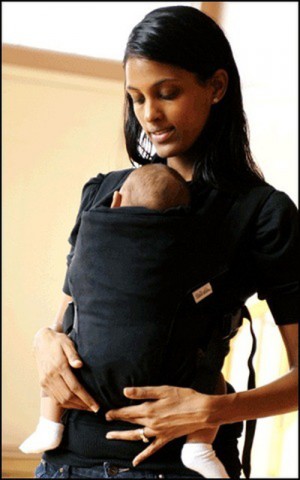
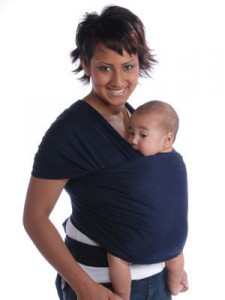

There are no comments
Add yours